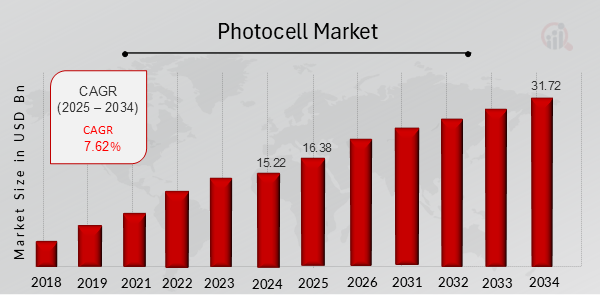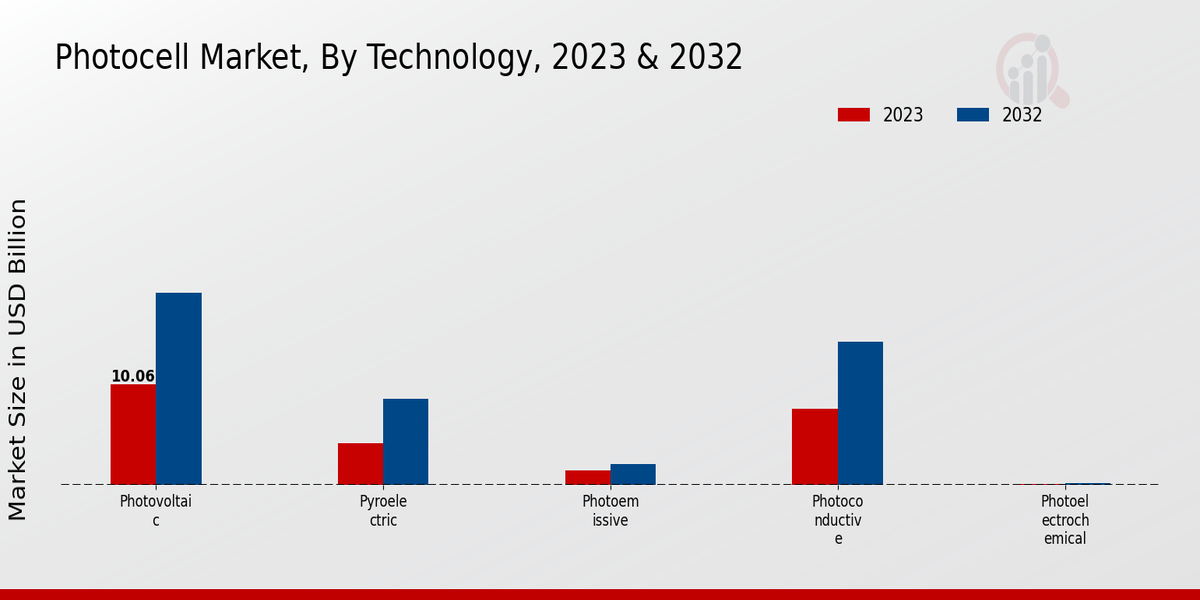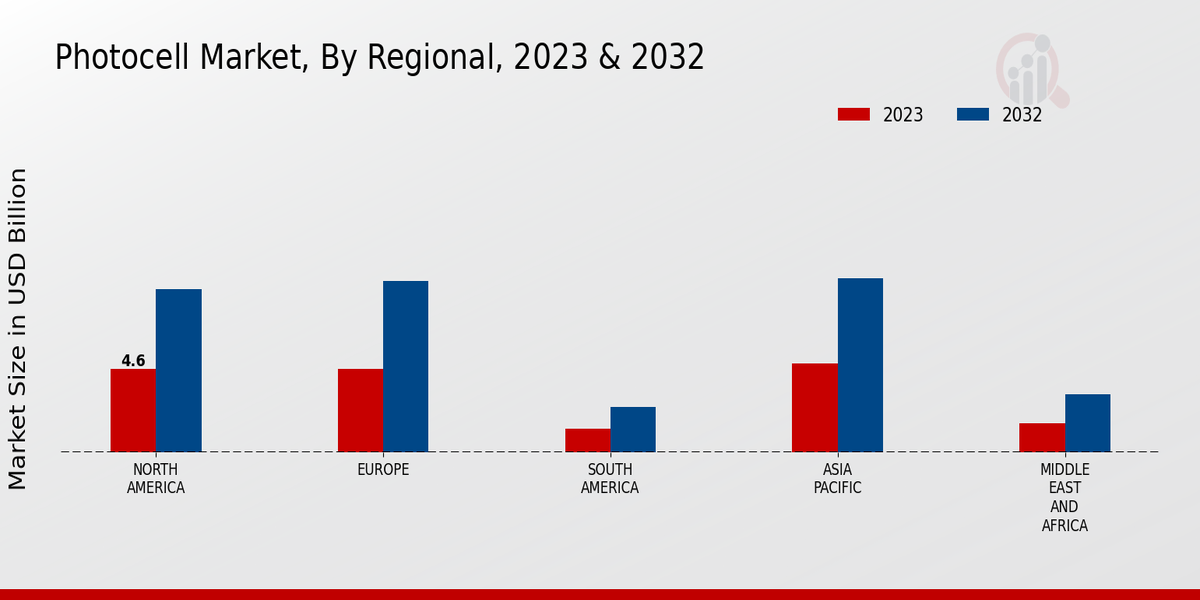Global Photocell Market Overview
As per MRFR analysis, the Photocell Market Size was estimated at 15.22 (USD Billion) in 2024. The Photocell Market Industry is expected to grow from 16.38 (USD Billion) in 2025 to 31.72 (USD Billion) till 2034, at a CAGR (growth rate) is expected to be around 7.62% during the forecast period (2025 - 2034)
Key Photocell Market Trends Highlighted
The Photocell Market is witnessing a surge in advancements, driven by the escalating demand for energy-efficient lighting solutions, the increasing adoption of smart lighting systems, and the growing popularity of IoT devices. The market is expected to expand substantially in the coming years due to the rising awareness about sustainability and the need for cost reduction in lighting applications.Key market drivers include the growing emphasis on energy conservation, government initiatives promoting energy-efficient lighting, and the increasing demand for smart lighting in residential, commercial, and industrial sectors.
Furthermore, the advent of IoT and the integration of photocells with smart controls and sensors are creating new opportunities for the market.Recent trends in the photocell market include the adoption of advanced technologies such as nanotechnology and semiconductor physics to improve photocell performance and efficiency. Additionally, the integration of photocells with wireless communication and cloud-based platforms is enabling remote monitoring and control of lighting systems, opening up new avenues for market growth. The increasing availability of wireless photocells is further enhancing the flexibility and affordability of these solutions, driving market expansion.

Source: Primary Research, Secondary Research, MRFR Database and Analyst Review
Photocell Market Drivers
Rising Demand for Energy-Efficient Lighting Solutions
The increasing global emphasis on energy conservation and sustainability has led to a surge in demand for energy-efficient lighting solutions. Photocells, which automatically adjust lighting intensity based on ambient light levels, play a crucial role in reducing energy consumption in both residential and commercial settings. Governments worldwide are implementing regulations and incentives to promote the adoption of energy-efficient technologies, further driving the growth of the Photocell Market Industry.Additionally, the growing awareness among consumers about the environmental benefits of energy conservation is contributing to the market's expansion.
Advancements in Smart Home and Building Automation
The rapid advancements in smart home and building automation systems have created new opportunities for photocells. These systems integrate various devices and appliances, allowing for automated control and monitoring of lighting, heating, and other functions. Photocells play a vital role in smart lighting systems, enabling automatic adjustment of light levels based on occupancy and ambient light conditions. This integration enhances convenience, energy efficiency, and security, driving the growth of the Photocell Market Industry.
Expansion of the Solar Energy Industry
The burgeoning solar energy industry has presented significant growth opportunities for photocells. Photocells are used in solar panels to convert sunlight into electricity. As the global transition towards renewable energy sources accelerates, the demand for solar panels is increasing rapidly. This trend is expected to continue in the coming years, fueled by government initiatives, technological advancements, and declining costs. The growth of the solar energy industry is a key driver for the expansion of the Photocell Market Industry.
Photocell Market Segment Insights:
Photocell Market Technology Insights
The Photocell Market market segmentation by Technology comprises Photovoltaic, Photoconductive, Photoemissive, Pyroelectric, and Photoelectrochemical segments. Among these, the Photovoltaic segment held the largest market share in 2023 and is projected to continue its dominance throughout the forecast period. The growth of this segment can be attributed to the increasing adoption of solar energy and the rising demand for renewable energy sources. Photovoltaic cells convert light energy directly into electrical energy, making them a promising technology for clean and sustainable energy generation.
The Photoconductive segment is another significant segment in the Photocell Market market. Photoconductive cells exhibit a change in electrical conductivity when exposed to light, making them suitable for various applications, including photodetectors, light sensors, and optical switches. The growing demand for these devices in consumer electronics, industrial automation, and automotive applications is driving the growth of the Photoconductive segment. Photoemissive cells, which emit electrons when exposed to light, represent a smaller segment in the Photocell Market market.These cells are commonly used in vacuum tubes, photomultipliers, and other devices requiring high sensitivity to light.
The Photoemissive segment is expected to witness steady growth over the forecast period due to its applications in scientific research and specialized industrial applications. Pyroelectric cells, which generate an electrical charge when exposed to changes in temperature, constitute a niche segment in the Photocell Market market. These cells are primarily used in infrared sensors, thermal imaging systems, and fire detection applications.The growing demand for these devices in security, military, and industrial settings is fueling the growth of the Pyroelectric segment. Photoelectrochemical cells, which convert light energy into chemical energy, represent a nascent segment in the Photocell Market market. These cells are still under development and have potential applications in water splitting, hydrogen production, and artificial photosynthesis. The Photoelectrochemical segment is expected to gain traction in the coming years as research and development efforts continue to advance this technology.

Source: Primary Research, Secondary Research, MRFR Database and Analyst Review
Photocell Market Application Insights
Segmentation of the market based on application reveals that the 'Light Detection and Measurement' segment held the largest market share of 30.5% in 2023. This segment is anticipated to continue its dominance throughout the forecast period, reaching a valuation of $7.82 billion by 2032. The 'Solar Energy Conversion' segment is another significant segment, accounting for a market share of 25.2% in 2023. It is estimated to reach a value of $6.4 billion by 2032, expanding at a CAGR of 7.9%. The 'Image Sensors' segment is poised to witness substantial growth, registering a CAGR of 8.2% during the forecast period.It is projected to reach a valuation of $5.3 billion by 2032. 'Optical Communications' and 'Sensors and Control' segments are also expected to contribute significantly to the overall market growth.
Photocell Market Spectral Range Insights
The Photocell Market is segmented based on Spectral Range into Ultraviolet, Visible, Infrared, X-ray, and Gamma Ray. Among these segments, the Visible segment held the largest market share in 2023, accounting for over 40% of the Photocell Market revenue. The Ultraviolet segment is expected to grow at the highest CAGR of 8.3% during the forecast period, driven by the increasing demand for UV photocells in medical and industrial applications. The Infrared segment is also expected to witness significant growth due to its applications in thermal imaging and spectroscopy.The X-ray and Gamma Ray segments are expected to grow at a moderate pace, with increasing adoption in security and medical imaging applications.
Photocell Market Material Insights
The Material segment of the Photocell Market is expected to grow significantly in the coming years, driven by the increasing demand for photocells in various applications such as solar energy, consumer electronics, and automotive. Among the different material types used in photocells, Silicon holds the largest market share due to its high efficiency, low cost, and wide availability. Gallium Arsenide (GaAs) is another important material used in photocells, offering higher efficiency and longer lifespan compared to Silicon. Cadmium Telluride (CdTe) is a low-cost alternative to Silicon and GaAs, making it suitable for large-scale solar applications.Copper Indium Gallium Selenide (CIGS) is a thin-film material gaining popularity due to its high absorption coefficient and flexibility. Organic Semiconductors are emerging materials with potential applications in flexible and low-cost photocells. The Photocell Market revenue for the Material segment is projected to reach USD 13.14 billion in 2023 and is expected to grow at a CAGR of 7.6% to reach USD 25.4 billion by 2032, offering ample growth opportunities for market participants.
Photocell Market Regional Insights
The regional segmentation of the Photocell Market offers valuable insights into the market's growth dynamics and competitive landscape. In 2023, North America held the largest market share, accounting for nearly 35% of the global revenue. The region's advanced infrastructure, technological advancements, and growing demand for energy-efficient solutions contribute to its dominance. Europe follows closely behind, driven by stringent regulations promoting energy conservation and the increasing adoption of renewable energy sources. The APAC region is expected to witness significant growth over the forecast period, with countries like China and India emerging as major markets due to rapid urbanization, rising disposable incomes, and government initiatives supporting the adoption of photocells.South America and the MEA region are expected to experience steady growth, driven by increasing awareness of energy efficiency and government initiatives promoting sustainable practices.

Source: Primary Research, Secondary Research, MRFR Database and Analyst Review
Photocell Market Key Players And Competitive Insights:
Major players in the Photocell Market industry are continuously striving to innovate their product offerings to gain a competitive edge in the Photocell Market industry. They are also focusing on expanding their geographical reach to cater to a larger customer base. In addition, leading Photocell Market players are actively involved in research and development to create new technologies that meet the evolving needs of their customers, thus driving Photocell Market development.
Hamamatsu Photonics K.K. is a leading player in the Photocell Market; the company has a strong focus on research and development, operating multiple research centers worldwide and actively collaborating with universities and institutes. The company's wide range of products includes photomultiplier tubes, photodiodes, solid-state photodetectors, detectors, and imaging devices. Hamamatsu Photonics K.K. has a wide geographical reach with operations in Asia, Europe, and North America, and it continues to expand its presence globally.
Thorlabs, Inc. is another major player in the Photocell Market; the company's offerings include optoelectronic components, systems, and accessories. Its strength lies in its comprehensive product portfolio, which caters to a diverse range of industries, including life sciences, industrial, and research. Thorlabs, Inc. has a global presence and has established a strong distribution network to ensure the quick delivery of its products to customers.
Key Companies in the Photocell Market Include:
- ON Semiconductor
- Panasonic
- Sun Electronics
- First Sensor
- Sharp
- ams Osram
- ROHM Semiconductor
- Hamamatsu Photonics
- Renesas Electronics
- Vishay Intertechnology
- Broadcom
- Everlight Electronics
- Excelitas Technologies
- SensL
Photocell Market Industry Developments
The Photocell Market is anticipated to witness significant growth over the forecast period, driven by increasing demand from various end-use industries such as consumer electronics, automotive, and industrial automation. The market is expected to reach a valuation of USD 16.38 billion by 2025, expanding at a CAGR of 7.62% from 2025 to 2034.
Technological advancements, such as the development of high-efficiency and low-power photocells, are further fueling market growth. Strategic partnerships and acquisitions among key players, such as the collaboration between First Sensor and ams AG, are shaping the competitive landscape. Emerging applications in sectors like renewable energy and healthcare are also contributing to the market's expansion.
Photocell Market Segmentation Insights
Photocell Market Technology Outlook
- Photovoltaic
- Photoconductive
- Photoemissive
- Pyroelectric
- Photoelectrochemical
Photocell Market Application Outlook
- Light Detection and Measurement
- Solar Energy Conversion
- Image Sensors
- Optical Communications
- Sensors and Control
Photocell Market Spectral Range Outlook
- Ultraviolet
- Visible
- Infrared
- X-ray
- Gamma Ray
Photocell Market Material Outlook
- Silicon
- Gallium Arsenide
- Cadmium Telluride
- Copper Indium Gallium Selenide
- Organic Semiconductors
Photocell Market Regional Outlook
- North America
- Europe
- South America
- Asia Pacific
- Middle East and Africa
| Report Attribute/Metric |
Details |
|
Market Size 2024
|
15.22 (USD Billion)
|
|
Market Size 2025
|
16.38 (USD Billion)
|
|
Market Size 2034
|
31.72 (USD Billion)
|
|
Compound Annual Growth Rate (CAGR)
|
7.62% (2025 - 2034)
|
|
Report Coverage
|
Revenue Forecast, Competitive Landscape, Growth Factors, and Trends
|
|
Base Year
|
2024
|
|
Market Forecast Period
|
2025 - 2034
|
|
Historical Data
|
2019 - 2023
|
| Market Forecast Units |
USD Billion |
| Key Companies Profiled |
ON Semiconductor, Panasonic, Sun Electronics, First Sensor, Sharp, ams Osram, ROHM Semiconductor, Hamamatsu Photonics, Renesas Electronics, Vishay Intertechnology, Broadcom, Everlight Electronics, Excelitas Technologies, SensL |
| Segments Covered |
Technology, Application, Spectral Range, Material, Regional |
| Key Market Opportunities |
1 Increasing demand for energy-efficient devices2 Growing adoption in consumer electronics3 Expansion of smart grid infrastructure4 Rise of IoT applications5 Government initiatives promoting sustainability |
| Key Market Dynamics |
Increasing adoption of solar energy, rising demand for energy efficiency technological advancements, government incentives, growing awareness of environmental sustainability |
| Countries Covered |
North America, Europe, APAC, South America, MEA |
Frequently Asked Questions (FAQ) :
The Photocell Market is expected to reach USD 13.14 Billion in 2023.
The Photocell Market is expected to reach USD 25.4 Billion by 2032.
The Photocell Market is expected to grow at a CAGR of 7.6% from 2024 to 2032.
Asia Pacific is expected to hold the largest market share in the Photocell Market.
Industrial applications are expected to drive the growth of the Photocell Market.
Key competitors in the Photocell Market include AMS AG, Broadcom Inc., Hamamatsu Photonics K.K., ON Semiconductor, and Panasonic Corporation.
Key trends in the Photocell Market include the increasing adoption of IoT devices and the growing demand for energy-efficient lighting.
Challenges faced by the Photocell Market include the availability of low-cost alternatives and the lack of standards.
Opportunities for growth in the Photocell Market include the increasing demand for security and surveillance systems.
The Photocell Market is expected to reach USD 19.2 Billion by 2028.

















